Grounding What it is and how to do it (part 1)

My story will consist of three parts.
1 part. Grounding
(general information, terms and definitions)
2 part. Traditional construction methods for grounding devices
(description, calculation, installation)
3 part. Modern methods of building grounding devices
(description, calculation, installation)
In the first part (theory) I will describe the terminology, the main types of grounding (purpose) and the requirements for grounding.
In the second part (practice) there will be a story about traditional solutions used in the construction of grounding devices, listing the advantages and disadvantages of these solutions.
The third part (practice) will in some sense continue the second. It will contain a description of new technologies used in the construction of grounding devices. As in the second part, listing the advantages and disadvantages of these technologies.
')
If the reader has theoretical knowledge and is interested only in practical implementation, it is better for him to skip the first part and start reading from the second part.
If the reader has the necessary knowledge and wants to get acquainted with the novelties only, it is better to skip the first two parts and go straight to reading the third.
My view on the described methods and solutions is somewhat one-sided. I ask the reader to understand that I am not putting forward my material for comprehensive objective work and express my point of view, my experience in it.
Some of the text is a compromise between accuracy and the desire to explain the "human language", so simplified, able to "cut the ear" of a technically savvy reader.
1 part. Grounding
In this part I will talk about terminology, the main types of grounding and the quality characteristics of grounding devices.A. Terms and definitions
B. Purpose (types) of grounding
B1. Working (functional) grounding
B2. Safety groundB2.1. Grounding in the external lightning protection
B2.2. Grounding as part of an overvoltage protection system (SPD)
B2.3. Grounding in the grid
B. Grounding quality. Ground resistance.
IN 1. Factors affecting grounding quality
B1.1. Contact area of the grounding conductor with the ground
B1.2. Ground electric resistance (specific)AT 2. Existing grounding resistance standards
IN 3. Earth Resistance Calculation
A. Terms and definitions
To avoid confusion and misunderstanding in the further story - I'll start with this point.I will give the established definitions from the current document “Rules for the Electrical Installation Device (OED)” in the latest edition (chapter 1.7 in the seventh edition).
And I will try to “translate” these definitions into “simple” language.
Grounding is the deliberate electrical connection of any network point, electrical installation or equipment with a grounding device ( 1.7.28).
Soil is a medium that has the property of “absorbing” the electric current. It also represents some “common” point in the electrical circuit, with respect to which the signal is perceived.
Grounding device - a set of grounding / earthing and grounding conductors ( 1.7.19).
This is a device / circuit consisting of a grounding conductor and a grounding conductor connecting this grounding conductor to the grounded part of the network, electrical installation or equipment. It can be distributed, i.e. consist of several mutually distant earthing.
In the figure it is shown in thick red lines:
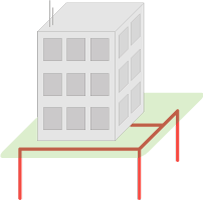
Grounding conductor - a conductive part or a set of interconnected conductive parts that are in electrical contact with the ground (PUE 1.7.15).
The conductive part is a metal (conductive) element / electrode of any profile and structure (pin, pipe, strip, plate, grid, bucket :-), etc.) located in the ground and through which electric current flows into it from electrical installations.
The configuration of the ground (the number, length, location of the electrodes) depends on the requirements for it, and the ability of the soil to “absorb” the electric current flowing / “flowing” from the electrical installation through these electrodes.
In the picture it is shown in thick red lines:
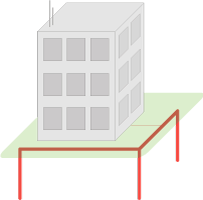
Grounding resistance - the ratio of the voltage on the grounding device to the current flowing from the grounding to the ground (PUE 1.7.26).
Grounding resistance is the main indicator of a grounding device, which determines its ability to perform its functions and determines its quality as a whole.
The grounding resistance depends on the area of electrical contact of the grounding conductor (grounding electrodes) with the ground (“draining” of the current) and the specific electrical resistance of the soil in which this grounding conductor is mounted (“absorbing” the current).
Grounding electrode (earthing electrode) - conductive part in electrical contact with local ground (GOST R 50571.21-2000 p. 3.21)
I repeat: a metal (conductive) element of any profile and structure (pin, pipe, strip, plate, grid, bucket :-), etc.) located in the ground and through which it “flows” can act as a conductive part electrical current from electrical installations.
In the figure they are shown in thick red lines:
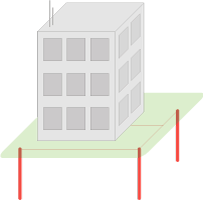
Further definitions that are not met or not described accurately enough in standards and norms, therefore, having only my description.
The grounding circuit - the “popular” name of the grounding or grounding device, consisting of several grounding electrodes (a group of electrodes), connected to each other and mounted around the object along its perimeter / contour.
In the figure, the object is indicated by a gray square in the center,
and the ground loop - thick red lines:
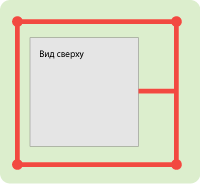
The specific electrical resistance of the soil is a parameter that determines the level of "electrical conductivity" of the soil as a conductor, that is, how well the electric current from the grounding electrode will spread in such an environment.
This is a measurable quantity depending on the composition of the soil, size and density.
fit to each other of its particles, humidity and temperature, the concentration of soluble chemicals in it (salts, acid and alkaline residues).
B. Purpose (types) of grounding
Grounding is divided into two main types according to the role to be fulfilled - working (functional) and protective. Additional sources are also given in various sources, such as: “instrumental”, “measuring”, “control”, “radio”.B1. Working (functional) grounding
This is the grounding of a point or points of current-carrying parts of an electrical installation, which is performed to ensure the operation of an electrical installation (not for electrical safety purposes) (EIR 1.7.30).Working grounding (electrical contact with the ground) is used for the normal functioning of electrical installations or equipment, i.e. for their work in the NORMAL mode.
B2. Safety ground
This grounding is performed for electrical safety purposes ( 1.7.29).Protective grounding provides protection for electrical installations and equipment, as well as protection of people from exposure to dangerous voltages and currents that may occur during breakdowns, improper use of equipment (i.e. in EMERGENCY mode) and during lightning discharges.
Also, protective grounding is used to protect equipment from interference with switching in the supply network and interface circuits, as well as from electromagnetic interference induced by equipment operating alongside.
In more detail, the protective purpose of grounding can be considered in two examples:
- as part of an external lightning protection system in the form of a grounded interception rod
- as part of a surge protection system
- as part of the object's power grid
B2.1. Grounding as part of lightning protection
Lightning is a discharge or, in other words, “breakdown”, arising from the cloud to the earth, when a critical charge is accumulated in the cloud (relative to the earth). Examples of this phenomenon on a smaller scale are “breakdown” ( wiki ) in a capacitor and gas discharge ( wiki ) in a lamp.
Air is a medium with very high resistance (dielectric), but the discharge overcomes it, because has great power. The path of discharge passes through areas of least resistance, such as water droplets in the air and trees. This explains the root-like structure of lightning in the air and the frequent lightning entering the trees and buildings (they have less resistance than the air in this gap).
When it gets into the roof of a building, the lightning continues on its way to the ground, also selecting areas with the least resistance: wet walls, wires, pipes, electrical appliances - thus posing a danger to humans and equipment located in this building.
Lightning protection is designed to divert the discharge of lightning from the protected building / object. A lightning bolt that follows the path of least resistance gets into a metal lightning rod over an object, then goes down metal ground lightning arresters outside the object (for example, on walls) to the ground, where it diverges in it (I remind you: the soil is a medium that has the “absorb “Electric current itself).
In order to make lightning protection “attractive” for lightning, as well as to exclude the spread of lightning currents from lightning protection parts (receiver and taps) into the object, it is connected to the ground through a grounding conductor having a low grounding resistance.

Grounding in such a system is a mandatory element, since it provides the complete and rapid transition of lightning currents to the ground, preventing them from spreading through the object.
B2.2. Grounding as part of a surge protection system (SPD)
Surge protection device designed to protect electronic equipment from the charge accumulated on any part of the line / network as a result of the electromagnetic field (EMF) induced by a nearby powerful electrical installation (or high-voltage line) or EMF arising from close (to hundreds of meters) discharge lightning
A striking example of this phenomenon is the accumulation of charge on the copper cable of the house network or on the “forwarding” between buildings during a thunderstorm. At some point, the devices connected to this cable (computer network card or switch port) do not withstand the “size” of the accumulated charge and electrical breakdown occurs inside this device, destroying it (simplified).
For “bleeding” the accumulated charge parallel to the “load” on the line in front of the equipment puts an SPD.
A classic surge arrester is a gas discharger ( wiki ) designed for a certain “threshold” of charge, which is less than the “safety margin” of the protected equipment. One of the electrodes of this spark gap is grounded, and the other is connected to one of the line / cable wires.
When this threshold is reached, a discharge arises inside the spark gap :-) between the electrodes. As a result, the accumulated charge is discharged into the ground (through grounding).
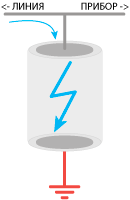
As in lightning protection, grounding in such a system is an essential element, since it is precisely this that ensures the timely and guaranteed occurrence of a discharge in the SPD, preventing the charge from exceeding on the line above the safe level for the protected equipment.
B2.3. Grounding in the grid
The third example of the protective role of grounding is to ensure human and electrical safety in the event of a breakdown / accident.The easiest way of such a breakdown is described by the closure of the phase conductor of the electrical network to the device body (short circuit in the power supply unit or short circuit in the water heater through the water environment). A person who touches such a device will create an additional electrical circuit through which the current will run, causing injuries to the internal organs in the body, primarily the nervous system and the heart.
To eliminate such consequences, the connection of bodies with a grounding conductor is used (to divert emergency currents into the ground) and automatic protective devices that in a split second cut off the current in an emergency situation.
For example, the grounding of all buildings, cabinets and racks of telecommunications equipment.
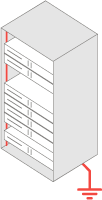
B. Grounding quality. Ground resistance.
To properly perform the grounding of its functions, it must have certain parameters / characteristics. One of the main properties that determine the quality of grounding is the resistance to current spreading (resistance to grounding), which determines the ability of the grounding device (grounding electrodes) to transfer currents flowing from the equipment to the ground.This resistance has finite values and in the ideal case is a zero value, which means the absence of any resistance when passing “harmful” currents (this guarantees their FULL absorption by the soil).
IN 1. Factors affecting grounding quality
Resistance mainly depends on two conditions:- area (S) of the electrical grounding contact with the ground
- electrical resistance (R) of the soil itself, in which the electrodes are located
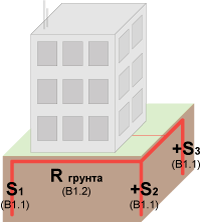
B1.1. The area of contact of the grounding with the ground.
The greater the area of contact of the earthing with the ground, the greater the area for the current to transfer from this earthing to the ground (the more favorable conditions are created for the current to flow into the ground).It is possible to increase the contact area of the grounding conductor with the ground by either increasing the number of electrodes, connecting them together (adding up the areas of several electrodes), or increasing the size of the electrodes. When using vertical grounding electrodes, the latter method is very effective if the deep soil layers have a lower electrical resistance than the upper ones.
B1.2. Ground electric resistance (specific)
Let me remind you: this is the value that determines how well the soil conducts current through itself. The less resistance the soil has, the more effective / easier it will be to “absorb” the current from the grounding plane.Examples of soils that conduct electricity well are salt marshes or highly moist clay. The ideal natural environment for passing current is sea water.
An example of a “bad” grounding ground is dry sand.
(If interested, you can see the table of the values of the resistivity of soils used in the calculations of grounding devices).
Returning to the first factor and method of reducing the grounding resistance in the form of increasing the electrode depth, we can say that in practice in more than 70% of cases, the soil at a depth of more than 5 meters has several times lower electrical resistivity than the surface, due to greater humidity and density . Often there are groundwater, which provides very low resistance to the ground. Grounding in such cases is very high quality and reliable.
AT 2. Existing grounding resistance standards
Since the ideal (zero resistance to spreading) cannot be achieved, all electrical equipment and electronic devices are created on the basis of some normalized values of ground resistance, for example, 0.5, 2, 4, 8, 10, 30 or more Ohms.For orientation, I will give the following values:
- for a substation with a voltage of 110 kV, the resistance to the spreading of currents should be no more than 0.5 Ohm ( 1.7.90)
- when connecting telecommunications equipment , the ground usually must have a resistance of no more than 2 or 4 ohms
- For reliable operation of gas dischargers in overhead line protection devices (for example, a local area network based on copper cable or radio frequency cable), the grounding resistance to which they (dischargers) are connected should be no more than 2 Ohms. There are instances with a requirement of 4 ohms.
- at the current source (for example, a transformer substation), the grounding resistance should be no more than 4 ohms at a linear voltage of 380 V of a three-phase current source or 220 V of a single-phase current source (PUE 1.7.101)
- for grounding, used to connect interception rods, the resistance should be no more than 10 Ohms (RD 34.21.122-87, p. 8)
- for private houses, with 220 volt / 380 volt electrical connection:
- when using the TN-CS system, it is necessary to have a local grounding with a recommended resistance of no more than 30 ohms (focusing on the 1.7.103)
- when using the TT system (isolation of grounding from the neutral source of the current source) and the use of a protective shutdown device (RCD) with a response current of 100 mA, it is necessary to have a local grounding with a resistance of not more than 500 Ohm ( 1.7.59)
IN 3. Earth Resistance Calculation
For a successful design of a grounding device that has the necessary grounding resistance, typically, typical grounding configurations and basic formulas for calculations are used.The grounding configuration is usually chosen by the engineer on the basis of his experience and the possibility of its (configuration) use on a particular object.
The choice of calculation formulas depends on the selected grounding configuration.
The formulas themselves contain the parameters of this configuration (for example, the number of grounding electrodes, their length, thickness) and the soil parameters of a particular object where the grounding conductor will be placed. For example, for a single vertical electrode, this formula will be as follows:

Calculation accuracy is usually low and depends again on the ground - in practice, the discrepancy between practical results is found in almost 100% of cases. This is due to its (soil) large inhomogeneity: it varies not only in depth but also in area - forming a three-dimensional structure. The available formulas for calculating the parameters of grounding hardly cope with the one-dimensional heterogeneity of the soil, and the calculation in the three-dimensional structure is fraught with enormous computing power and requires extremely high operator training.
In addition, to create an accurate soil map, it is necessary to produce a large amount of geological work (for example, for an area of 10 * 10 meters, it is necessary to make and analyze about 100 holes with a length of up to 10 meters), which causes a significant increase in the cost of the project and most often is not possible.
In the light of the above, the calculation is almost always compulsory, but an approximate measure, and is usually carried out according to the principle of achieving ground resistance “no more than”. The formulas are substituted for the averaged values of the resistivity of the soil, or their largest values. This provides a “margin of safety” and, in practice, is expressed in a deliberately lower (lower means better) grounding resistance values than expected in the design.
Construction grounding
In the construction of earthing most often used vertical grounding electrodes. This is due to the fact that horizontal electrodes are difficult to be buried to a greater depth, and when these electrodes are shallow, they greatly increase the grounding resistance (deterioration of the main characteristic) in winter due to the freezing of the upper soil layer, leading to a large increase in its specific electrical resistance.Steel tubes, pins / rods, angles, etc. are almost always chosen as vertical electrodes. standard rolled products having a greater length (more than 1 meter) with relatively small transverse dimensions. This choice is associated with the possibility of easy penetration of such elements into the ground, unlike, for example, from a flat sheet.
More information about construction - in the following parts.
Continued:
Alexey Rozhankov, specialist of the technical center " ZANDZ.ru "
In preparing this part, the following materials were used:
- Publications on the site “ Grounding on ZANDZ.ru ”
- Electrical Installation Rules (PUE), part 1.7 as amended by the seventh edition ( google )
- 50571.21-2000 ( 60364-5-548-96)
, ( ) - 34.21.122-87 ( )
- Own experience and knowledge
Source: https://habr.com/ru/post/144464/
All Articles